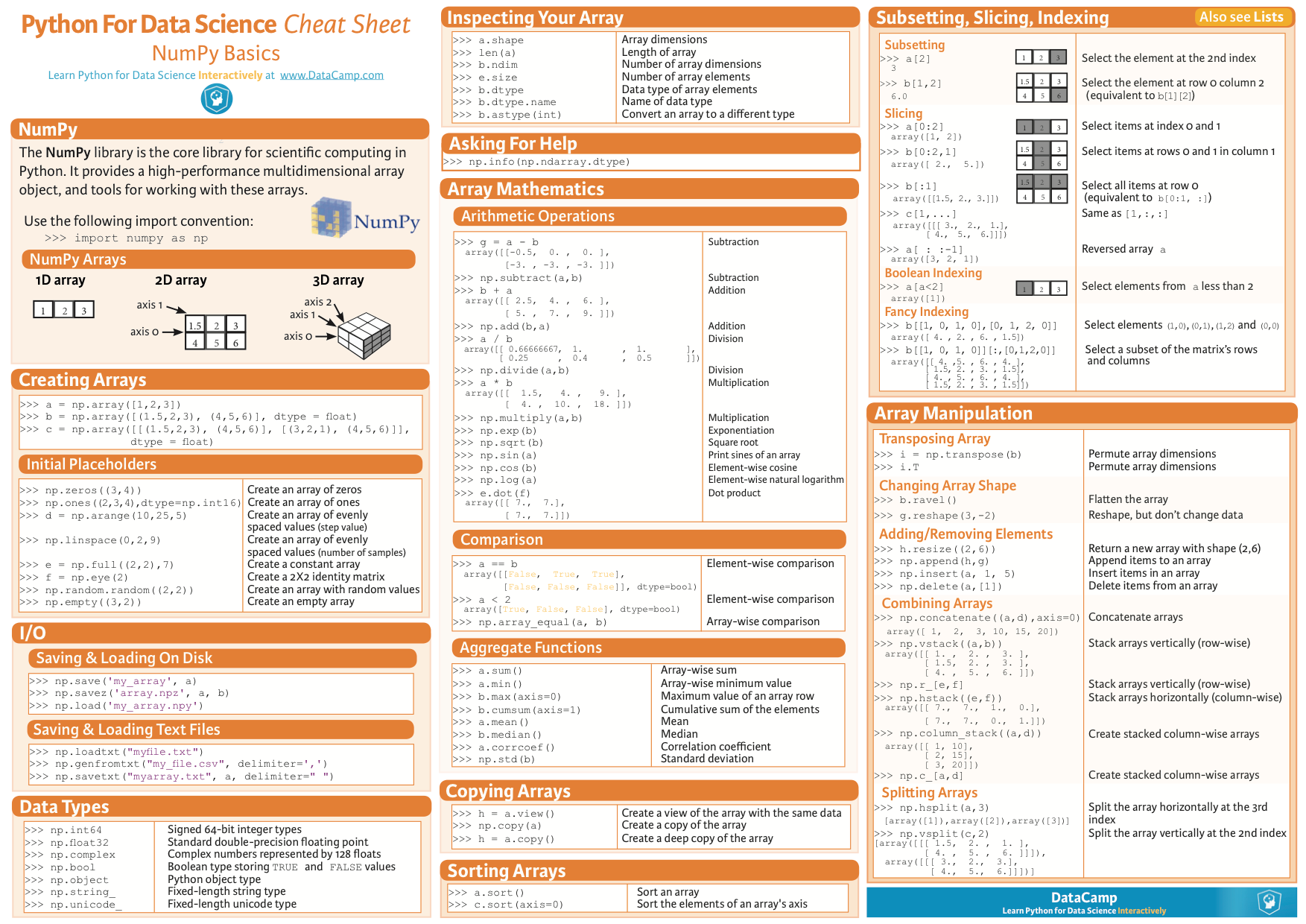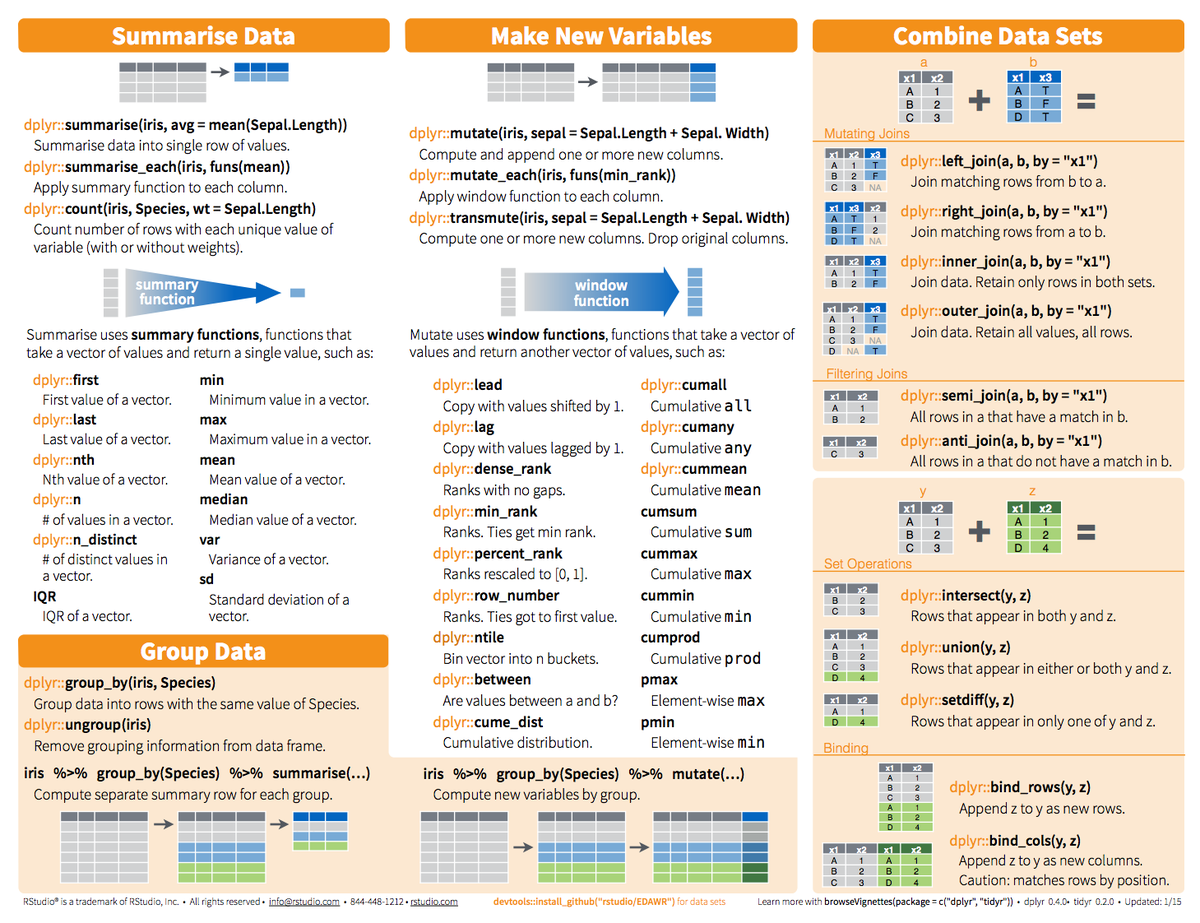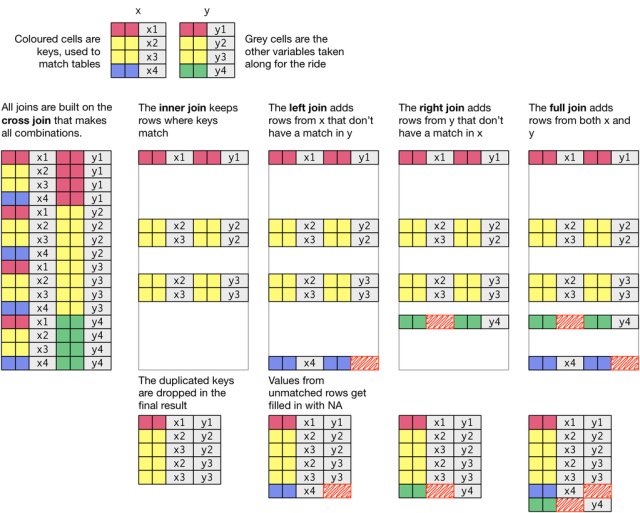- Dplyr Left Join
- R Dplyr Join Two Tables
- R Dplyr Cheat Sheet
- Dplyr Join By 2 Variables
- Rstudio Dplyr Cheat Sheet
- Dplyr Join Cheat Sheet Printable
Dplyr fulljoin In a full join, R data frame objects are merged together with the dplyr function fulljoin. Corresponding rows with a matching column value in each data frame are combined into one row of a new data frame, and non-matching rows are also added to the resultant data frame with NA s for the missing information. Dplyr ‘s fulljoin function will perform a full join, where non-matching rows are. Dplyr‘s groupby function can group together rows of a data frame with the same value(s) in either a specified column or multiple columns, allowing for the application of summary functions on the individual groups. Groupby changes the unit of analysis from a complete dataset to individual groups. For example, consider a data frame countries.To find the mean and standard deviation of.
data.table and dplyr cheat-sheet
This is a cheat-sheet on data manipulation using data.table and dplyr package (sqldf will be included soon…) . The package dplyr is an excellent and intuitive tool for data manipulation in R. Due to its intuitive data process steps and a somewhat similar concepts with SQL, dplyr gets increasingly popular. Another reason is that it can be integrated in SparkR seamlessly. Mastering dplyr will be a must if you want to get started with SparkR.
I found this cheat-sheet very useful in using dplyr. My post is inspired by it. I hereby write this cheat sheet for data manipulation with data.table / data.frame and dplyr computation side by side. It is especially useful for those who wants to convert data manipulation style from data.table to dplyr. There are 6 data investigation and manipulation included:
- Summary of data
- subset rows
- subset columns
- summarize data
- group data
- create new data
Select rows that meet logical criteria:
dplyr Good seeting for obs on mac book pro 2015.
data.frame / data.table
Remove duplicate rows:
dplyr
data.table
Randomly select fraction of rows
dplyr
Randomly select n rows
dplyr
data.table / data.frame
Select rows by position
dplyr
data.table / data.frame
Dplyr Left Join
Select and order top n entries (by group if group data)
dplyr

data.table
dplyr
data.frame
> iris[c(‘Sepal.Width’,’Petal.Length’,’Species’)]
data.table

Select columns whose name contains a character string
Select columns whose name ends with a character string
Select every column
dplyr
data.frame
Select columns whose name matches a regular expression
Select columns names x1,x2,x3,x4,x5
select(iris, num_range(‘x’, 1:5))
Select columns whose names are in a group of names
Select column whose name starts with a character string
Select all columns between Sepal.Length and Petal.Width (inclusive)
Select all columns except Species.
dplyr
data.frame
The package dplyr allows you to easily compute first, last, nth, n, n_distinct, min, max, mean, median, var, st of a vector as a summary of the table.
Summarize data into single row of values
dplyr
Apply summary function to each column
Note: mean cannot be applied on Factor type.
Count number of rows with each unique value of variable (with or without weights)
dplyr
data.table:
aggregate {stats}
Group data into rows with the same value of Species
dplyr
data.table: this is usually performed with some aggregation computation
Remove grouping information from data frame

dplyr
Compute separate summary row for each group
dplyr
data.frame
data.table
Mutate used window function, function that take a vector of values and return another vector of values, such as:
R Dplyr Join Two Tables
compute and append one or more new columns
data.frame / data.table
dplyr
Apply window function to each column
dplyr
base
data.table
R Dplyr Cheat Sheet
Compute one or more new columns. Drop original columns
Compute new variable by group.
dplyr
iris %>% group_by(Species) %>% mutate(ave = mean(Sepal.Length))
data.table
iris[, ave:=mean(Sepal.Length), by = Species]
data.frame
You can verify the result df1, df2 using:
R/join.rThese are generic functions that dispatch to individual tbl methods - see themethod documentation for details of individual data sources. x andy should usually be from the same data source, but if copy isTRUE, y will automatically be copied to the same source as x.
Arguments
| x, y | tbls to join |
|---|---|
| by | a character vector of variables to join by. If To join by different variables on x and y use a named vector.For example, |
| copy | If |
| suffix | If there are non-joined duplicate variables in |
| .. | other parameters passed onto methods, for instance, |
| keep | If |
| name | the name of the list column nesting joins create. If |

Join types
Currently dplyr supports four types of mutating joins, two types of filtering joins, anda nesting join.
Mutating joins combine variables from the two data.frames:
inner_join()return all rows from x where there are matchingvalues in y, and all columns from x and y. If there are multiple matchesbetween x and y, all combination of the matches are returned.
left_join()return all rows from x, and all columns from xand y. Rows in x with no match in y will have NA values in the newcolumns. If there are multiple matches between x and y, all combinationsof the matches are returned.
right_join()
return all rows from y, and all columns from xand y. Rows in y with no match in x will have NA values in the newcolumns. If there are multiple matches between x and y, all combinationsof the matches are returned.
full_join()return all rows and all columns from both x and y.Where there are not matching values, returns NA for the one missing.
Filtering joins keep cases from the left-hand data.frame:
semi_join()return all rows from x where there are matchingvalues in y, keeping just columns from x. A semi join differs from an inner join because an inner join will returnone row of x for each matching row of y, where a semijoin will never duplicate rows of x.
anti_join()return all rows from x where there are notmatching values in y, keeping just columns from x.
Nesting joins create a list column of data.frames:
Dplyr Join By 2 Variables
nest_join()return all rows and all columns from x. Adds alist column of tibbles. Each tibble contains all the rows from ythat match that row of x. When there is no match, the list column isa 0-row tibble with the same column names and types as y. nest_join() is the most fundamental join since you can recreate the other joins from it.An inner_join() is a nest_join() plus an tidyr::unnest(), and left_join() is anest_join() plus an unnest(.drop = FALSE).A semi_join() is a nest_join() plus a filter() where you check that every element of data hasat least one row, and an anti_join() is a nest_join() plus a filter() where you check every element has zero rows.
Grouping
Rstudio Dplyr Cheat Sheet
Groups are ignored for the purpose of joining, but the result preservesthe grouping of x.
Dplyr Join Cheat Sheet Printable
Examples
